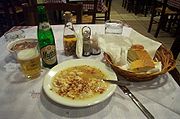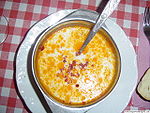
İşkembe
Encyclopedia

Tripe
Tripe is a type of edible offal from the stomachs of various farm animals.-Beef tripe:...
soup in the Turkish
Turkish cuisine
Turkish cuisine is largely the heritage of Ottoman cuisine, which can be described as a fusion and refinement of Central Asian, Middle Eastern and Balkan cuisines. Turkish cuisine has in turn influenced those and other neighbouring cuisines, including that of western Europe...
and some Balkan
Balkans
The Balkans is a geopolitical and cultural region of southeastern Europe...
cuisines. It is often seasoned with vinegar
Vinegar
Vinegar is a liquid substance consisting mainly of acetic acid and water, the acetic acid being produced through the fermentation of ethanol by acetic acid bacteria. Commercial vinegar is produced either by fast or slow fermentation processes. Slow methods generally are used with traditional...
or lemon juice
Lemon juice
The lemon fruit, from a citrus plant, provides a useful liquid when squeezed. Lemon juice, either in natural strength or concentrated, is sold as a bottled product, usually with the addition of preservatives and a small amount of lemon oil.-Uses:...
. In the South Slavic languages, this soup is called Shkembe chorba (Cyrillic: Шкембе чорба).
Etymology
The name is from Persian languagePersian language
Persian is an Iranian language within the Indo-Iranian branch of the Indo-European languages. It is primarily spoken in Iran, Afghanistan, Tajikistan and countries which historically came under Persian influence...
shikambeh 'stomach/tripe' + shorba 'thick soup', from shir + ba 'milk broth'. It entered the Slavic languages via Ottoman Turkish
Ottoman Turkish language
The Ottoman Turkish language or Ottoman language is the variety of the Turkish language that was used for administrative and literary purposes in the Ottoman Empire. It borrows extensively from Arabic and Persian, and was written in a variant of the Perso-Arabic script...
.
Variants
In Bulgaria a whole pork, beef or lamb tripe is boiled for few hours, chopped in small pieces, and returned to the broth. The soup is spiced with ground red paprikaPaprika
Paprika is a spice made from the grinding of dried fruits of Capsicum annuum . In many European languages, the word paprika refers to bell peppers themselves. The seasoning is used in many cuisines to add color and flavor to dishes. Paprika can range from mild to hot...
which is briefly fried (запръжка), and often small quantity of milk is added. In some areas it is thickened by adding flour to the paprika during frying. Traditionally the soup is served with mashed garlic in vinegar and hot red pepper. There is a variant of the soup with intestines instead of tripe.
The soup was very popular with the working classes until late 1980s, and there were many restaurants serving only shkembe chorba (шкембеджийница, "shkembe-restaurant"). Later they got replaced by fast food restaurants but the soup is still highly regarded, and is part of the menu in any cheap to moderately-priced restaurant. Office workers avoid eating shkembe chorba at lunch, or eat it without adding garlic.
In Serbia, this soup is made of fresh tripe cooked with onion
Onion
The onion , also known as the bulb onion, common onion and garden onion, is the most widely cultivated species of the genus Allium. The genus Allium also contains a number of other species variously referred to as onions and cultivated for food, such as the Japanese bunching onion The onion...
s, garlic
Garlic
Allium sativum, commonly known as garlic, is a species in the onion genus, Allium. Its close relatives include the onion, shallot, leek, chive, and rakkyo. Dating back over 6,000 years, garlic is native to central Asia, and has long been a staple in the Mediterranean region, as well as a frequent...
and paprika
Paprika
Paprika is a spice made from the grinding of dried fruits of Capsicum annuum . In many European languages, the word paprika refers to bell peppers themselves. The seasoning is used in many cuisines to add color and flavor to dishes. Paprika can range from mild to hot...
. It is usually seasoned with fried bacon
Bacon
Bacon is a cured meat prepared from a pig. It is first cured using large quantities of salt, either in a brine or in a dry packing; the result is fresh bacon . Fresh bacon may then be further dried for weeks or months in cold air, boiled, or smoked. Fresh and dried bacon must be cooked before eating...
and more garlic, sometimes thickened with flour
Flour
Flour is a powder which is made by grinding cereal grains, other seeds or roots . It is the main ingredient of bread, which is a staple food for many cultures, making the availability of adequate supplies of flour a major economic and political issue at various times throughout history...
(запршка). Some versions of shkembe chorba are made with milk; garlic, vinegar, and chili peppers are often added as seasoning.
The Greek version is usually called patsás (πατσάς < from Persian
Persian language
Persian is an Iranian language within the Indo-Iranian branch of the Indo-European languages. It is primarily spoken in Iran, Afghanistan, Tajikistan and countries which historically came under Persian influence...
pacheh 'shank', (pa+cheh, 'foot/leg+lower'), via Ottoman Turkish
Ottoman Turkish language
The Ottoman Turkish language or Ottoman language is the variety of the Turkish language that was used for administrative and literary purposes in the Ottoman Empire. It borrows extensively from Arabic and Persian, and was written in a variant of the Perso-Arabic script...
), and sometimes skembés (σκεμπές). It may be seasoned with red wine vinegar and garlic (skordostoubi), or thickened with avgolemono
Avgolemono
Avgolemono is a family of Mediterranean sauces and soups made with egg and lemon juice mixed with broth, heated until they thicken. Avgolémono 'egg-lemon' is the Greek name; in Arabic, it is called tarbiya or beida bi-lemoune 'egg with lemon'; and in Turkish terbiye...
. The Greek version sometimes uses calf feet with the tripe.
The Romanian
Romanian language
Romanian Romanian Romanian (or Daco-Romanian; obsolete spellings Rumanian, Roumanian; self-designation: română, limba română ("the Romanian language") or românește (lit. "in Romanian") is a Romance language spoken by around 24 to 28 million people, primarily in Romania and Moldova...
name is ciorbă
Ciorba
Ciorbă , from Persian, via the Turkish word çorba is a general Romanian word describing sour soups consisting of various vegetables and meat...
de burtă, having as a variant ciorbă de ciocănele (soup from chicken legs), similar in preparation and serving. "Ciorba de burta" is often seasoned with vinegar and sauce of crushed garlic mixed with a little bit of oil, called "mujdei". In Romania to make the soup sour (ciorbă) one generally adds a home-made juice called borş (fermented wheat bran).

See also
Other tripe soups include:- flaki (PolishPolish cuisinePolish cuisine is a style of cooking and food preparation originating from Poland. It has evolved over the centuries due to historical circumstances. Polish national cuisine shares some similarities with other Central European and Eastern European traditions as well as French and Italian...
) - dršťková polévka (CzechCzech cuisineCzech cuisine has both influenced and been influenced by the cuisines of surrounding countries. Many of the fine cakes and pastries that are popular in Central Europe originated in the Czech lands. Czech cuisine is marked by a strong emphasis on meat dishes. Pork is quite common, and beef and...
) - drskova polievka (SlovakSlovak cuisineSlovak cuisine varies slightly, though sometimes dramatically, from region to region. It was influenced by the traditional cuisine of its neighbours and it influenced these as well...
) - MenudoMenudo (soup)The soup Menudo is a traditional Mexican dish, made with beef stomach in a clear broth or with a red chili base . Usually, lime, chopped onions, and chopped cilantro are added, as well as crushed oregano and crushed red chili peppers...
(MexicanMexican cuisineMexican cuisine, a style of food that originates in Mexico, is known for its varied flavors, colourful decoration and variety of spices and ingredients, most of which are native to the country. The cuisine of Mexico has evolved through thousands of years of blending indigenous cultures, with later...
)

